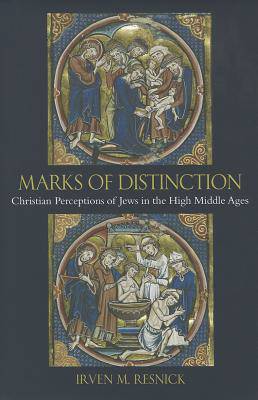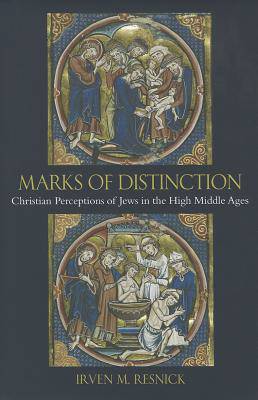
- Afhalen na 1 uur in een winkel met voorraad
- Gratis thuislevering in België vanaf € 30
- Ruim aanbod met 7 miljoen producten
- Afhalen na 1 uur in een winkel met voorraad
- Gratis thuislevering in België vanaf € 30
- Ruim aanbod met 7 miljoen producten
Marks of Distinction
Christian Perceptions of Jews in the High Middle Ages
Irven M ResnickOmschrijving
For medieval Latin Christendom, authoritative texts such as the Bible and the writings of the Fathers of the Church provided a skeleton that gave form to Christian perceptions of Jews and Judaism. Eye-witness testimony, hearsay, reports of converts from Judaism, and the testimony of dreams, visions, and miraculous events helped fill in the body with concrete detail. In this newest work, renowned author and scholar Irven Resnick explores the additional support drawn from medieval science. Resnick presents a captivating study of long-held medieval scientific theories that predisposed Jews to certain types of offensive behavior or even to communicate certain illnesses and disease. By arguing for a Jewish "nature" dictated by specific physical characteristics, medieval scientific authorities contributed to growing fears of a Jewish threat.
Through the use of several illustrations from illuminated manuscripts and other media, Resnick engages readers in a discussion of the later medieval notion of Jewish difference. Externally, these differences were evidenced by marks that physically distinguished Jews--and especially Jewish males--from their Christian neighbors, for example the mark of circumcision. Internally, their melancholy humoral complexion, further weakened by the Jews' dietary restrictions, was thought to dictate their temperament and sexual mores, and to incline them toward leprosy, bleeding hemorrhoids, and other infirmities. These differences were viewed by some as ineradicable, even following religious conversion; or, at best, erasable with only the greatest difficulty over several generations.
This work clarifies that the one doctrine of modern anti-Semitism typically thought to distinguish it so clearly from medieval anti-Judaism--the impossibility of escaping one's identity as a Jew even through religious conversion--had begun to appear by the end of the Middle Ages.
ABOUT THE AUTHOR:
Irven M. Resnick is professor of philosophy and religion, and Chair of Excellence in Judaic Studies at the University of Tennessee at Chattanooga. He is a corresponding fellow at the Ingeborg Rennert Center for Jerusalem Studies at Bar-Ilan University and a senior associate at the Oxford Centre for Hebrew and Jewish Studies. His most recent publications include translations of Albert the Great's Questions concerning Aristotle's "On Animals"; Petrus Alfonsi's Dialogue Against the Jews; and Peter Damian's Letters, all published in the Fathers of the Church Mediaeval Continuation Series by CUA Press.
PRAISE FOR THE BOOK
"This is a book of generous profusion. It should be read not just by those interested in medieval Jews, but by all concerned to understand the fears that lead majorities to persecute minorities as an enemy within." --Catholic Historical Review
Specificaties
Betrokkenen
- Auteur(s):
- Uitgeverij:
Inhoud
- Aantal bladzijden:
- 385
- Taal:
- Engels
Eigenschappen
- Productcode (EAN):
- 9780813219691
- Verschijningsdatum:
- 29/05/2012
- Uitvoering:
- Hardcover
- Formaat:
- Genaaid
- Afmetingen:
- 155 mm x 236 mm
- Gewicht:
- 816 g

Alleen bij Standaard Boekhandel
Beoordelingen
We publiceren alleen reviews die voldoen aan de voorwaarden voor reviews. Bekijk onze voorwaarden voor reviews.











